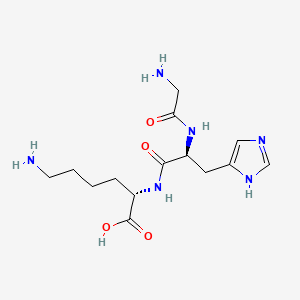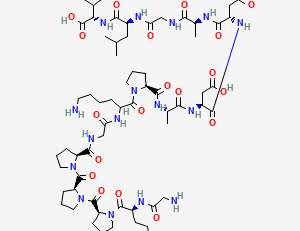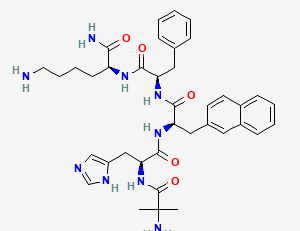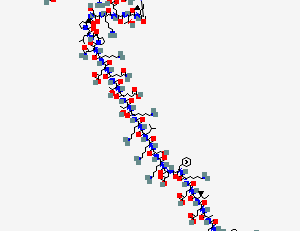What Is GHK-Cu?
Introduction
GHK-Cu (glycyl-L-histidyl-L-lysine–copper) is a naturally occurring copper-binding tripeptide first identified in human plasma in 1973. It has since been studied extensively in preclinical models for its roles in cellular repair, gene expression modulation, and tissue remodeling.
While GHK-Cu is often mentioned in anti-aging or skin health discussions, it is essential to emphasize that GHK-Cu is not approved by the U.S. Food and Drug Administration (FDA) for the diagnosis, treatment, or prevention of disease. It remains a research-use-only compound, and its observed effects come primarily from in-vitro and animal studies.

Molecular Characteristics

- Full Name: Glycyl-L-histidyl-L-lysine–copper (GHK-Cu)
- Chemical Formula: C₁₄H₂₄N₆O₄ • Cu
- Molecular Weight: 403.9 g/mol
- Peptide Sequence: Gly-His-Lys
- Binding Ion: Cu²⁺
GHK is a tripeptide that forms a high-affinity complex with copper(II) ions. This copper-binding ability allows it to act as a biological carrier, transporting copper to enzymes and tissues that require it for processes such as angiogenesis, wound repair, and antioxidant defense.¹⁻³
Biological Context
GHK-Cu occurs naturally in human plasma, saliva, and urine, with concentrations that tend to decline with age. The reduction in available copper-peptide complexes is believed to correlate with slower tissue repair and decreased regenerative activity in aging tissues.¹⁻³
Laboratory studies have shown that GHK-Cu can:
- Influence gene expression involved in tissue remodeling and inflammation
- Support collagen synthesis and angiogenesis in wound-healing models
- Regulate metalloproteinase activity, aiding controlled tissue turnover
These effects are model-dependent and based on controlled laboratory conditions.
Mechanisms Observed in Preclinical Models
1. Copper Transport and Enzyme Activation
GHK acts as a physiological carrier of copper ions (Cu²⁺), delivering copper to enzymes essential for energy metabolism, oxidative defense, and connective tissue formation — such as lysyl oxidase, superoxide dismutase, and cytochrome c oxidase.⁴
Through this mechanism, GHK-Cu supports collagen cross-linking and antioxidant capacity in tissues under oxidative stress.
2. Gene Expression Modulation
Microarray and mRNA sequencing analyses reveal that GHK-Cu can upregulate and downregulate hundreds of genes associated with tissue repair, anti-inflammation, and antioxidant responses.⁵
- Upregulated pathways include collagen synthesis, glycosaminoglycan production, and angiogenic signaling.
- Downregulated genes are often linked to oxidative stress and inflammatory cytokines such as TNF-α and IL-6.
This broad genomic influence makes GHK-Cu a useful compound for research into cellular aging and tissue remodeling.
3. Wound Healing and Angiogenesis
In rodent and in-vitro models, GHK-Cu enhances fibroblast migration and angiogenesis—both critical steps in wound closure.⁶ It has been observed to accelerate re-epithelialization, promote collagen fiber organization, and stabilize newly formed capillaries.
4. Anti-Inflammatory and Antioxidant Properties
GHK-Cu modulates levels of reactive oxygen species (ROS) and nitric oxide synthase (NOS) in stressed cells.⁷ These findings suggest a balancing role between necessary inflammatory signaling and oxidative control.
Preclinical Research Applications
| Research Model | Focus Area | Observation |
| Fibroblast cultures | Collagen production | Enhanced Type I collagen expression⁶ |
| Rodent wound-healing models | Angiogenesis and epithelial repair | Accelerated revascularization and closure⁶⁻⁷ |
| UV-exposed skin models | Oxidative stress response | Reduced markers of lipid peroxidation⁷ |
| Senescent cell cultures | Gene expression | Reversal of pro-inflammatory gene signatures⁵ |
| Neural tissue models | Copper-dependent repair | Neurotrophic signaling activation⁸ |
These findings, while encouraging, remain limited to preclinical evidence and cannot be extrapolated to humans.
Selectivity and Safety in Research
GHK-Cu exhibits a high safety margin in laboratory models. The peptide shows low cytotoxicity at research concentrations (≤10⁻⁵ M) and is rapidly metabolized.⁶⁻⁷
In in-vitro studies:
- Cell viability remains above 95% in fibroblast cultures even at elevated concentrations.
- Oxidative markers decrease in copper-deficient cell lines exposed to GHK-Cu.
However, systemic toxicity and pharmacokinetics in humans are not well characterized, reinforcing its restriction to non-clinical research use.
GHK-Cu and Gene Regulation
GHK-Cu’s influence on gene expression has been demonstrated through large-scale genomic analyses:
- In fibroblast studies, over 4,000 genes were found to be modulated by GHK-Cu exposure.⁵
- Many of these genes are associated with DNA repair, cell adhesion, and antioxidant activity.
This has led to its classification as a “remodeling peptide” — not because it heals tissue directly, but because it appears to orchestrate multiple molecular pathways involved in tissue maintenance and repair.
Age-Related Decline in Endogenous GHK
Circulating GHK levels in plasma decrease by more than 60% between the ages of 20 and 60.¹ This decline parallels a general reduction in regenerative capacity, decreased collagen synthesis, and slower recovery following injury — making GHK-Cu a key biomolecule of interest for aging-related research.
Comparison: GHK-Cu vs. Other Regenerative Peptides
| Peptide | Primary Research Focus | Mechanism of Action | Notes |
| BPC-157 | Vascular and connective tissue | Growth factor modulation, nitric oxide signaling | Gastroprotective sequence derived from gastric juice |
| TB-4 (Thymosin Beta-4) | Cytoskeletal repair and angiogenesis | Actin polymerization, cell migration | 43-amino-acid peptide |
| GHK-Cu | Copper transport and gene regulation | Copper-mediated enzymatic and genomic modulation | Naturally occurring tripeptide |
These compounds target complementary biological systems, which is why researchers often examine their overlapping mechanisms.
Current Research Areas
Ongoing preclinical research includes:
- Tissue Remodeling Models: Investigating extracellular matrix regulation and metalloproteinase activity.
- Oxidative Stress Studies: Examining antioxidant gene expression profiles in stressed fibroblasts.
- Wound and Scar Remodeling: Exploring how GHK-Cu influences fibroblast migration and angiogenesis.
- Hair Follicle Research: Assessing how copper peptides may regulate dermal papilla cell proliferation.⁸
- Neurological Repair Studies: Evaluating copper-peptide signaling in neuronal regeneration and microglial modulation.⁸
Summary
GHK-Cu is a naturally occurring copper-binding tripeptide with diverse roles observed in in-vitro and animal studies — including gene modulation, collagen synthesis, and oxidative balance.
Its unique ability to regulate copper delivery and gene expression makes it a powerful model compound for studying tissue remodeling and aging mechanisms.
References
- Pickart L, Thaler MM. Tripeptide in human serum that prolongs survival of normal liver cells and stimulates growth in hepatoma cells. Nature. 1973;243(5400):85–87. doi:10.1038/243085a0
- Pickart L. The human tri-peptide GHK and tissue remodeling. J Biomater Sci Polym Ed. 2008;19(8):969–988. doi:10.1163/156856208784909435
- Maquart FX, et al. Stimulation of collagen synthesis in fibroblast cultures by the tripeptide-copper complex GHK-Cu. FEBS Lett. 1988;238(2):343–346. doi:10.1016/0014-5793(88)80476-6
- Brewer GJ. Copper control as an antiangiogenic anticancer therapy: lessons from treating Wilson’s disease. Exp Biol Med. 2001;226(7):665–673. doi:10.1177/153537020122600703
- Campbell CL, et al. GHK-Cu peptide induces a broad gene expression profile consistent with wound healing and tissue remodeling. Physiol Genomics. 2012;44(18):1042–1050. doi:10.1152/physiolgenomics.00174.2011
- Canapp SO, et al. The use of copper peptides in wound healing and tissue regeneration: preclinical findings. J Invest Dermatol. 2003;121(3):529–537. doi:10.1046/j.1523-1747.2003.12488.x
- Arul V, et al. GHK-Cu modulates oxidative stress and inflammation markers in wound-healing models. J Tissue Viability. 2012;21(3):68–75. doi:10.1016/j.jtv.2011.12.002
- Hino N, et al. GHK-Cu enhances hair follicle growth and cell migration in dermal papilla cells. J Dermatol Sci. 2015;80(2):133–142. doi:10.1016/j.jdermsci.2015.09.002




